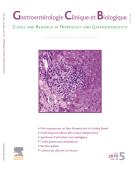Barrett’s esophagus, esophageal and esophagogastric junction adenocarcinomas: The role of diet - 31/01/11

Summary |
Identification of modifiable risk factors is an attractive approach to primary prevention of esophageal adenocarcinoma (EAC) and esophagogastric junction adenocarcinoma (EGJAC). We conducted a review of the literature to investigate the association between specific dietary components and the risk of Barrett’s esophagus (BE), EAC and EGJAC, supposing diet might be a risk factor for these tumors. Consumption of meat and high-fat meals has been found positively associated with EAC and EGJAC. An inverse association with increased intake of fruit, vegetables and antioxidants has been reported but this association was not consistent across all studies reviewed. Few studies have examined the association between diet and BE. Additional research is needed to confirm the aforementioned association and clarify the mechanisms by which dietary components affect the risk of developing EAC and EGJAC. Future studies could advance our knowledge by emphasizing prospective designs to reduce recall bias, by using validated dietary intake questionnaires and biological measures and by considering important confounders such as gastro-esophageal reflux disease (GERD) symptoms, tobacco and alcohol use, biometrics, physical activity, and socioeconomic factors.
Il testo completo di questo articolo è disponibile in PDF.Résumé |
L’identification de facteurs de risque susceptibles d’être modifiés, représente une stratégie intéressante dans la prévention primaire de l’adénocarcinome de l’œsophage (AO) et de la jonction œsogastrique (AJO). Nous avons révisé la littérature pour analyser l’association entre certaines composantes nutritionnelles et le risque de développer l’endobrachyœsophage (EBO), l’AO et l’AJO. Une importante association a été retrouvée entre la consommation de viande et de produits riches en gras et le risque de développer l’AO et l’AOJ. D’autres études identifiés une corrélation inverse avec une alimentation riche en fruits, légumes et antioxydants, même si cette association n’était pas consistante dans tous les études. Très peu d’études ont analysé l’association entre nutrition et EBO. D’ultérieures recherches seront nécessaires pour confirmer cette association et éclaircir les mécanismes par lesquels les composantes nutritionnelles peuvent affecter le risque de développer l’AO et l’AJO. Ultérieures études perspectives pourront améliorer notre connaissance en réduisant les biais d’information, avec l’usage de questionnaires nutritionnels préalablement validés, des tests biologiques de mesures et en considérant d’autres facteurs confondants comme les symptômes liés au reflux, la consommation de tabac et d’alcool, la biométrie, l’activité physique et les facteurs socioéconomiques.
Il testo completo di questo articolo è disponibile in PDF.Mappa
Vol 35 - N° 1
P. 7-16 - Febbraio 1997 Ritorno al numeroBenvenuto su EM|consulte, il riferimento dei professionisti della salute.

